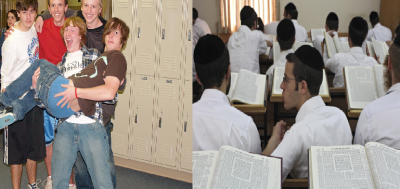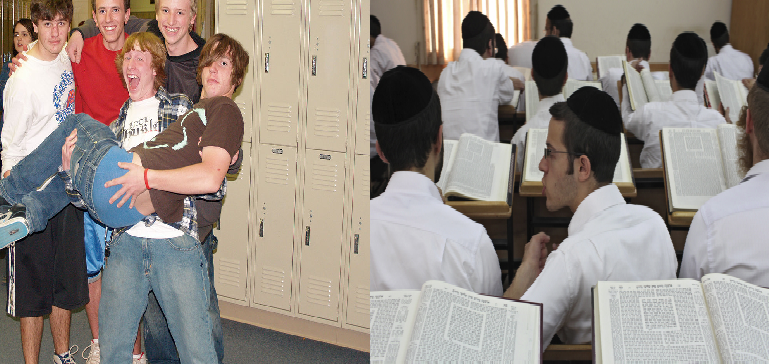
This semester, I read C. J. Pascoe’s Dude, You’re A Fag, an ethnography of a typical American public high school. To summarize some of Pascoe’s “findings” (I put “findings” in quotes because to most teenaged American boys, what follows may come as no surprise), high school boys become men in a two-part process: 1) embracing heterosexuality and 2) rejecting what Pascoe calls “the specter of the faggot.” What this means is that boys assert their heterosexuality by dominating women’s bodies verbally and physically and by doing traditionally masculine things like sports, working out, or auto shop class. At the same time, boys reject “the faggot,” which Pascoe discovers does not mean literal homosexuality, but rather femininity, by calling other boys “fags” and carefully avoiding behaviors that might land them in the “fag position,” such as caring about one’s appearance or being emotional. I found Pascoe’s revelations to be nothing shocking, but as I read the book, which is rich with anecdotal evidence, I wondered how this might contrast with Orthodox day schools.
My school was very different from “River High,” the pseudonymous archetypical high school where Pascoe conducted her year and a half long field study, I went to a Modern Orthodox day school which was co-ed until I was in seventh grade, when they split the boys and girls into two campuses. The school eventually closed after I was in ninth grade, due to long standing financial problems. With the split, I felt my school drift from being the Religious Zionist, Torah and Science school its mission statement proclaimed it was into becoming a more right-wing pseudo-yeshivah. Indeed, we had more Judaics classes than general studies, and several of the rabbis at our campus didn’t even believe in evolution. It was in this environment that I spent what can definitely be called my awkward years, from barely eleven years old until I was thirteen. Just as a Jewish boy formally becomes a man at age thirteen with his Bar Mitzvah, Pascoe takes note of the informal rituals the boys at River High underwent. And of course, these are also the years boys begin discovering their sexual drives.
My school was very different from River High. For one thing, not only were there no girls, which made a huge difference in the way we acted -we were more rambunctious and less self-conscious without girls around— we were expected to not talk to girls at all, and chas v’shalom* you openly date someone. Everyone was assumed to be shomer negiah, shomer kol isha, and to generally avoid women like good, upstanding bochurim** ought to. You absolutely cannot talk about sexual matters in class. At best, the rebbe would use euphemisms like “married” or “slept with”, and only rarely, in hurried tones. Of course, being adolescent boys, we did talk about sex, but it was with an air of mystique, in the form of crude campfire-stories to be expected of young boys who were taught that women were temptresses to be controlled. In some ways it was even scarier than the episode where a boy at River High chanted “GET RAPED! GET RAPED!” as another boy physically harassed a girl in the hallway, because we discoursed in a space in which women were nonexistent. We told ourselves about women, with no possibility for a dissenting voice. There was no sex education curriculum at all. Even though everyone did masturbate, no one would dare admit it, in sharp contrast to the boys at River High, whose peers expected them to brag about how much sex they were having. We had no female role models in our school. There were female teachers, yes, but they only taught general education subjects, which are considered ancillary to Judaic studies, which are entirely taught by men (except for Hebrew, which isn’t considered a religious class).
One of the walls of our two hallways had two dozen pictures of famous rabbis: Yosef Dov Soloveitchik, Avraham Kook, Yaakov Kamenetsky, and others, and a mirror with a caption taped onto it that read: “What About Me?” Our guest speakers were mostly men. A particularly memorable speaker came in the school’s final year, after the closing had been announced—the Kalever Rebbe, a mystic who was followed by two silent attendants, constantly standing behind him like looming Secret Service agents. He gave a speech after prayer, then we were all made to line up to meet with him in private. Afterwards, upon comparing notes, we discovered he did the same thing for all of us: he greeted us, asked for our email address (to which he later sent his holiday newsletters), and, while mushing our faces like a great-aunt that you only see at Thanksgiving, asked what school we were planning to attend next year. If we said we were going to a co-ed school, he would tell us it was a bad idea, and encourage us to go to one of Baltimore’s many all boy schools.
Now, while our school discouraged heterosexual contact, it by no means encouraged homosexual contact. Or homosexuality. Or any discussion of non-straight sexuality for that matter (by ‘discuss’, I of course mean ‘being told that the gay will burn in hell’). Non-straight people and non-cis people were always the Other, never a Jew; or, even if they were, they weren’t religious. If anyone in our school was queer (which is a statistical certainty), they would never dare reveal it. There was no “specter of the fag” with which we young teenagers had to grapple because homosexuality didn’t exist in our bubble.
However, going to a fairly right-wing Orthodox day school wasn’t always so bleak. One striking difference between our school community and River High’s is that traditional masculinity wasn’t as enforced. This seems a bit strange given the homophobic nature of our school, but on a peer level, kids (at least as far as I saw) were never bullied for being effeminate. Yes, the kids at the top of whatever social food chain existed were into both playing and spectating sports, but as a guy, I was never made fun of if I didn’t like playing football. While bullying wasn’t exactly nonexistent, it was a much more amiable atmosphere to be a guy who prefers sitting inside and reading instead of going outside and bashing peoples’ brains in. In my opinion, this is a strength of a system that encourages men to sit in a yeshivah and learn all day rather than go to the gym 24/7. Yeshivish Orthodoxy encourages men to be sensitive and bookish. Although testosterone did run high in my school’s all male space, it was, in essence, a place where nerdom like mine could still flourish relatively unmolested by jeers of “pussy!” or “fag!” like at River High. But then again, maybe I just got lucky.
The problem with enforcing masculinity is that gender is a spectrum. A person who identifies as female may still want to do traditionally male things such as wearing a tie, and she would still be female. What counts as “masculine” in some cultures, like Orthodox Jewish day schools, may not cut it in River High. If we want our children to grow up in an environment where they won’t risk being bullied for preferring passive hobbies over active ones, then we need to eschew this whole concept of what men ought to do. It’s not progressive enough to tell your child that men can like the color pink while simultaneously telling them that men don’t wear dresses. Abandon the idea of “what men do”. While Orthodox day schools are far away from being perfect, we have a lot to learn from them about the varying ways that masculinity can be done.
*God forbid
**Young men
Yitzi Turniansky is a student at Towson University.

